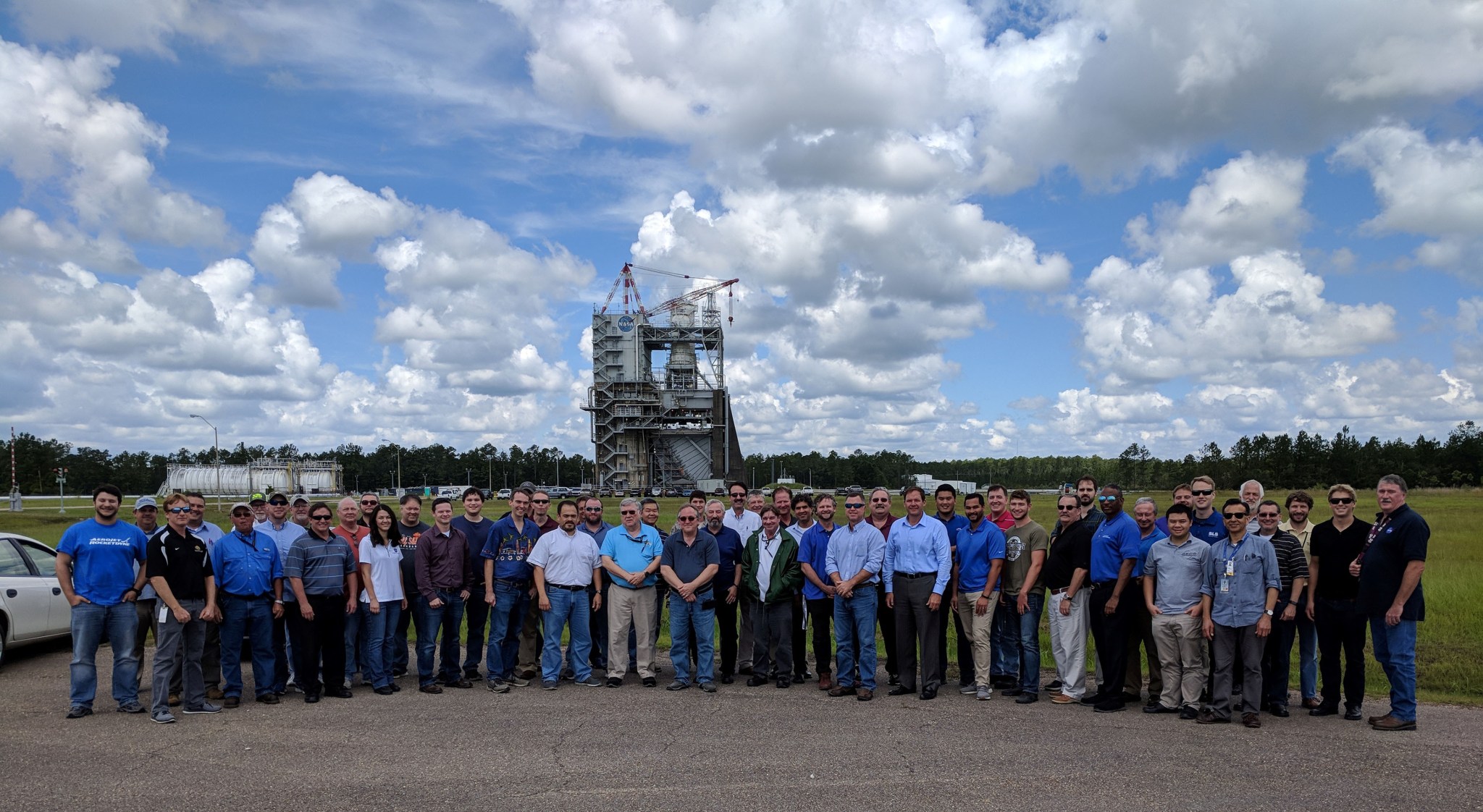An integrated test team received a prestigious national achievement award April 26 for a historic series of AR-22 rocket engine tests performed at NASA’s John C. Stennis Space Center near Bay St. Louis, Mississippi.
The Rotary National Award for Space Achievement (RNASA) Foundation presented its annual team Stellar Award to the AR-22 test crew, which included engineers and operators from NASA, the Defense Advanced Research Projects Agency (DARPA), The Boeing Company, Aerojet Rocketdyne and Syncom Space Services. The blended team was recognized for its unprecedented achievement of performing 10 AR-22 engine tests in a 240-hour period in June/July 2018.
“It is hard to put into words just how remarkable this test achievement is and how much I appreciate the team and the monumental effort they put forth,” said Mark Hancock, the NASA engineer at Stennis who managed the AR-22 test project. “This test series should have been extremely difficult, almost impossible. However, it went off virtually without a hitch. The team made it look easy.”
The testing accomplishment was not without challenges, however. Team members collaborated for 10 months, beginning in August 2017, to plan and prepare for the historic series. “This is hard,” Fred Kennedy, director of DARPA’s Tactical Technology Office, said during a presentation in April 2018. “It may not work. In fact, it’s likely to not work.”
The testing was designed as part of DARPA’s effort to develop an experimental spaceplane (XSP) – the Phantom Express – as a low-cost, reusable system for delivering small satellites into orbit. The goal of the effort is to build a vehicle that can be launched on short notice and with rapid turnaround times. The Boeing Company is building the Phantom Express, which will be powered by Aerojet Rocketdyne’s AR-22 engine, assembled using materials and components from early versions of the much-tested and highly reliable space shuttle main engine.
To demonstrate the quick-turnaround capability of the new vehicle, DARPA turned to Stennis with a never-before-attempted challenge – perform a series of 10 100-second tests on the AR-22 engine in a 10-day period (240 hours).
One of the key challenges from the outset was to reduce the time needed to dry the AR-22 engine and to perform needed inspections following each test. The AR-22 engine uses liquid oxygen and liquid hydrogen at super-cold temperatures and high pressures, the two mixing to form a highly combustible fuel. Of course, mixing oxygen and hydrogen in the right proportion also creates water.

Following a test, the engine has to be “dried” of any moisture that may have accumulated internally. To do so, pressurized nitrogen or air is pushed through the system and engine. The procedure is a must – and typically takes 18 to 72 hours. The blended team at Stennis was able to use knowledge and expertise acquired during more than 30 years of space shuttle main engine testing to reduce the drying/inspection time to six hours. The quicker turnaround process was planned down to 15-minute increments.
Team members conducted a pair of preliminary tests but were still finalizing turnaround procedures when the 10-test series kicked off June 26. All went well until a lightning strike June 29 as the team was preparing for the fifth hot fire. The strike caused substantial electrical/control systems damage at the A-1 Test Control Center and on the stand.
Team members responded with what one person described as a “herculean” effort of troubleshooting and repair, working through the night with multiple shifts. Additional lightning forced delay of the fifth test even after repairs were completed, and lightning struck again on July 2, this time with minimal damage. Despite the obstacles, testing resumed and continued through the July 4 holiday.
Just before noon on July 6, the Stennis test team conducted the 10th – and final – test in the turnaround series. Although it had been 11 calendar days since the first test of the series, all 10 of the 100-second hot fires had been completed in a 240-hour period – with a little more than an hour to spare.
Stennis Director Rick Gilbrech and others praised the blended team for the accomplishment, which kept the Phantom Express vehicle on track for its planned test flights in 2021. In addition to the test team itself, he cited the critical support provided by crews at the Stennis high-pressure gas facility, high-pressure water facility and cryogenic facility as well.
“All the credit goes to the great men and women who make up our exceptional team here at Stennis,” Hancock said. “We have extraordinary resources for all of our projects. Stennis is truly remarkable in that we have an extremely brilliant – and skilled – workforce at our disposal at all times. None of our projects would experience the levels of success we continually enjoy if this were not the case.”
As stated on its website, the RNASA Foundation was founded by the Space Center Rotary Club of Houston in 1985 to “recognize outstanding achievements in space and create greater public awareness of the benefits of space exploration.” In addition to the team recognition, it presents annual Stellar Awards in three individual age categories. Nominations for the awards are reviewed by a panel of scientists, managers, engineers and academicians who select the accomplishments that hold the greatest promise for furthering future activities in space.
For information about Stennis Space Center, visit:
Valerie Buckingham
Stennis Space Center, Bay St. Louis, Mississippi
228-688-3898
valerie.d.buckingham@nasa.gov

























